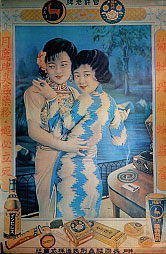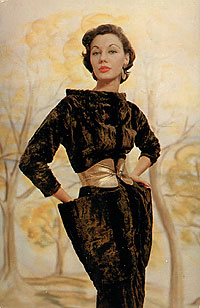 Twentieth-century Chinese advertisement for insect repellent
Twentieth-century Chinese advertisement for insect repellentThe elements of structure, with their rules and constituent parts, are merely a fanciful void without the imprimatur of some creative authorship that connects both style and expression to them. Elusive at best, style and expression are symbiotic in their manifestation of a truly creative enterprise. Inherent in style is the repetition of forms and ideas and the ways in which the expressive ingredients can be presented or arranged. For the purposes of definition, we might use Leonard Meyers's (American musicologist, 1918-2007) notion that style is a replication of patterning, whether in human behavior or artifacts produced by human behavior, which results from a series of choices made with some set of constraints— and we would add, calculated risks.
 Highboy chest,
Highboy chest,eighteenth century
The constraints are those rules or guidelines that are learned, adopted, broken, and re-invented through historical/cultural circumstances by individuals or groups. In the flux and flow of cultural exchange, the artist and the audience experience style as the ultimate synthesis of decisions regarding the limits of a given form of expression. Style is the balance between containing and pushing an idea. The meaning of a creative act—its resultant style—is the coming together of its elements of structure, techniques employed, and purpose to which it is put. Style is felt and is recognizable as it permeates the work. Both the audience and maker can understand it as something that gives an overall synthesis to the work and the oeuvre. Style is communicated over the entire score or body of work, not in a single passage or a given image. It results from repeated performance, practice, and thinking, and is spurred by insight and talent.
 Glamour girl, circa 1950s
Glamour girl, circa 1950sCertain conditions—an atmosphere—must exist within a culture that allows a style to be confirmed by an audience and to take hold. War and the technology of speed gave rise to Picasso's (Spanish-born painter, 1881-1973) fractured world. Cultural fatigue with the sterile minimalist architecture of the modernist gave authority to Robert Venturi (American architect, born 1925) and Michael Graves (American architect, born 1934), among others, whose gestures and referential ornament enlivened late twentieth-century architecture. Some psychological or utilitarian need within an audience is served by the creative act, which allows it to gain its authority from the audience reaction. Style lies in an agreement between audience and creator.
Freud (Austrian psychiatrist, 1856-1939) gives us further understanding of the psychological underpinnings of the expressive act as a turning away from reality through active, creative play: "An artist . . . allows his erotic and ambitious wishes full play in the life of fantasy. He finds the way back to reality, however, from his world of fantasy by making use of special gifts to mould his fantasies into truths of a new kind, which are valued by men as precious reflections of reality."
- R.G. Collingwood, Principles of Art
 Sophia Eliot Lipkin, Untitled, 2000
Sophia Eliot Lipkin, Untitled, 2000Calvin Tomkins (American author and art critic, born 1925) points out that "it takes considerable ingenuity to get beyond one's own self-expressed taste" to a new expressive language— style. In his discussion of the giants of twentieth-century art, he cites Duchamp (French artist, 1887-1968), Cage (American composer, 1912-92), Tinguely (Swiss artist, 1925-91), and Rauschenberg (American artist, born 1925) for their disrespect of traditional representations that impose the artist's meaning and interpretation of reality on the audience. The maker of metafora can block the imaginative order of his creation by obscuring the view of the receiver with his own emotions. Tompkins quotes Robert Rauschenberg: "Art is not an end but simply a means to function thoroughly and passionately in a world that has a lot more to it than paint." John Cage substituted chance for personal control by allowing the randomness of 'found sounds' to be themselves in his compositions. Tomkins sums up that Cage's desire was that music should not be concerned primarily with entertainment or communication, or the symbolic expression of the artist's ideas and taste, but should serve the function of helping the listeners achieve more awareness of their own lives. A Zen idea indeed.
- Susanne K. Langer, Feeling and Form
Garry Winogrand (American photographer 1928-84), when asked why he depicted a certain subject, replied, "To see what it looks like as a photograph," knowing that expression, and not reality, was embedded in the photographic paper. All metafora gives freedom to the need for stylistic gesture that drives it into the consciousness of culture and pushes the possibilities of the medium or form that contains it to new life. Those who can manipulate the elements of structure in such a way are deemed to have great style. They have shifted our view of the world, changing patterns and thus shifting our perspective. In the end, style is style. We may not be able to define it, but we know it when we see it.
- Eric Gill, An Essay on Typography
